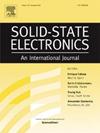改善纳米片场效应晶体管RC延迟的横向源极/漏极生长曲线优化
IF 1.4
4区 物理与天体物理
Q3 ENGINEERING, ELECTRICAL & ELECTRONIC
引用次数: 0
摘要
在不断发展的亚3nm技术节点,器件已经从FinFET发展到基于栅极的纳米片结构(nsfet)。这种转变解决了finfet的局限性,缩小尺寸会导致翅片数量减少,保持量子化宽度,导致电流可驱动性降低。相比之下,nsfet提供类似于传统平面结构的灵活宽度设计,允许多通道堆叠,增加电流,从电路设计的角度来看,使其成为有吸引力的候选者。然而,尽管栅极可控性得到了改善,但由于寄生RC元件的增加,nsfet在器件性能方面也面临着挑战。在这项工作中,我们使用3D TCAD模拟分析了具有不同源极/漏极生长曲线的nsfet中的寄生RC元件,然后检查RC延迟以确定具有最佳器件性能的源极/漏极生长曲线。此外,我们研究了自热效应(SHEs),以评估不同源/漏剖面的散热情况,并将这些发现与RC延迟分析相结合,提出了最佳生长剖面。本文章由计算机程序翻译,如有差异,请以英文原文为准。
Optimization of lateral source/drain growth profile for improving RC delay in nanosheet field-effect transistor
In the advancing sub-3 nm technology node, device evolution has progressed from FinFET to gate-all-around based nanosheet architectures (NSFETs). This transition addresses the limitations of FinFETs, where scaling down leads to a reduced number of fins, maintaining a quantized width and resulting in decreased current drivability. In contrast, NSFETs offer flexible width design similar to traditional planar structures and allow for multi-channel stacking, increasing current and making them an attractive candidate from a circuit design perspective. However, NSFETs also faces challenges in device performance due to increased parasitic RC components, despite improved gate controllability.
In this work, we analyzed parasitic RC components in NSFETs with different source/drain growth profiles using 3D TCAD simulations and then examined the RC delay to determine the source/drain growth profile that exhibits optimal device performance. Furthermore, we investigated self-heating effects (SHEs) to evaluate heat dissipation across different source/drain profiles, integrating these findings with RC delay analyses to propose the optimal growth profile.
求助全文
通过发布文献求助,成功后即可免费获取论文全文。
去求助
来源期刊

Solid-state Electronics
物理-工程:电子与电气
CiteScore
3.00
自引率
5.90%
发文量
212
审稿时长
3 months
期刊介绍:
It is the aim of this journal to bring together in one publication outstanding papers reporting new and original work in the following areas: (1) applications of solid-state physics and technology to electronics and optoelectronics, including theory and device design; (2) optical, electrical, morphological characterization techniques and parameter extraction of devices; (3) fabrication of semiconductor devices, and also device-related materials growth, measurement and evaluation; (4) the physics and modeling of submicron and nanoscale microelectronic and optoelectronic devices, including processing, measurement, and performance evaluation; (5) applications of numerical methods to the modeling and simulation of solid-state devices and processes; and (6) nanoscale electronic and optoelectronic devices, photovoltaics, sensors, and MEMS based on semiconductor and alternative electronic materials; (7) synthesis and electrooptical properties of materials for novel devices.
 求助内容:
求助内容: 应助结果提醒方式:
应助结果提醒方式:


